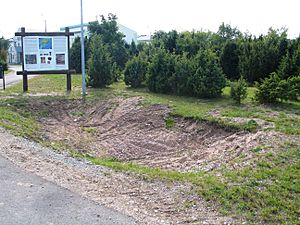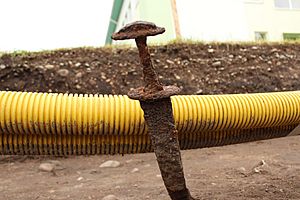Salme ships facts for kids
The Salme ships are two amazing ancient ships found in Estonia. They were discovered in 2008 and 2010 near a village called Salme on the island of Saaremaa. These ships were built in a special way called clinker-built, where the wooden planks overlap like roof tiles.
These ships were used as ship burials around 700 to 750 AD, during a time known as the Nordic Iron Age. Inside the ships, archaeologists found the bodies of 41 warriors who had died in a battle. They also found the remains of 6 dogs, 2 hunting hawks, and many weapons and other cool items.
Contents
Finding the Ancient Ships
The first ship was found by accident in 2008. Workers were moving earth for a new building project when they stumbled upon it. Soon after, a team of archaeologists started working at the site.
In 2010, they made another exciting discovery: a second, even larger ship! Some clues suggest there might be at least one more ship waiting to be found in the future.
Where the Ships Were Found
The ships were discovered close to where the ancient coastline used to be. They were about 1.5 meters (5 feet) above the old water level. Today, the site is about 230 meters (252 yards) from the current coastline. It is also about 4 meters (13 feet) above the present water level.
What the Ships Look Like
Both Salme ships were built using the clinker-built method. Experts believe they were built between 650 and 700 AD, most likely in what is now Sweden. The ships show signs that they had been repaired many times over decades before their final journey.
One ship is about 11.5 meters (38 feet) long and 2 meters (7 feet) wide. The second ship is even bigger, more than 17 meters (56 feet) long and 3 meters (10 feet) wide.
Archaeologists found the outline of a keel, which is the main bottom part of a ship, from the larger vessel. This, along with strong rivets found on the ship's bottom, suggests that this ship used a sail. This makes it the oldest known ship in the Baltic Sea area to use sails!
The Warriors Inside
Skeletal remains from at least 42 people were found in the two ships. Most of them were men between 30 and 40 years old. It looks like they all died in a battle.
Scientists studied the teeth of some of the men. This, along with the design of the items buried with them, suggests that these warriors came from central Sweden.
The smaller ship held the bodies of 7 individuals. The larger ship was packed with at least 36 individuals, buried in four layers. DNA tests showed that four of these men were brothers. They were also related to a fifth man, who might have been their uncle.
Treasures and Items Found
Many interesting objects were found in the burials. These included pieces of more than 40 swords of different kinds. There were also parts of shields, spearheads, and dozens of arrowheads. Most of these weapons had been bent or broken on purpose. This might have been done to stop grave robbers from taking them.
Smaller items found included a small socketed axe, knives, whetstones for sharpening tools, and a decorated bone comb. They also found a necklace made from a bear's claw, and hundreds of gaming pieces. These gaming pieces were made from whale bone and antler, and came with six dice.
The archaeologists also found the bodies of two dogs. These dogs were likely sacrificed as part of the burial ceremony. There were also hawks, which were probably used for falconry, a type of hunting with birds.



